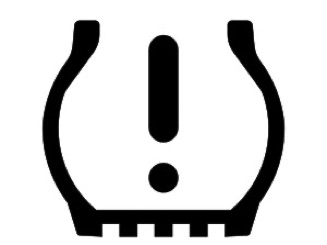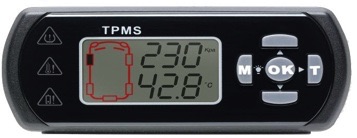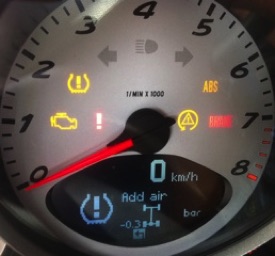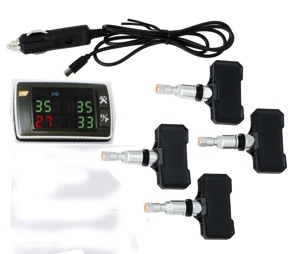
Published in the October 2013 issue of “Die Porsche Kassette”
First of all, TPMS does not stand for Terrible PMS as one of my customers referred to it when she saw the warning light come on and stay on in her 2006 Carrera S some time ago.
TPMS stands for Tire Pressure Monitoring System, and it is an electronic system designed to “keep an eye” on your car’s tire pressures for you. This system reports real-time tire pressures to the driver of the vehicle either by a simple warning light or by a more complex display indicating each individual tire’s actual pressure.
The system is available directly from the manufacturer on every car produced after September 2007, or as an aftermarket product which can be retrofitted to any older vehicle without the OEM technology.
There are two types of TPMS. There’s the direct TPMS (dTPMS) and indirect TPMS (iTPMS), but more on the differences later in the article.
First, the origins of TPMS.
The first passenger vehicle to include TPMS was the 1986 Porsche 959. Porsche felt that it was very important to give the driver information on his car’s tire pressures especially on this supercar which was arguably way ahead of its time.

But it wasn’t until the late 90s when the Firestone Tire Recall in the US (linked to over 100 fatalities due to rollovers because of tire tread separation) prompted the National Highway and Traffic safety Administration (NHTSA) of the Clinton Administration to legislate the TREAD Act (Transportation Recall Enhancement, Accountability and Documentation) which among other things, mandated the use of TPMS in all vehicles under 10,000 pounds. According to the TREAD Act, 20% of every manufacturer’s fleet sold in the US had to offer TPMS by October 2005 and 100% by September 2007.
The initial system used a simple warning light to indicate tire under-inflation.
Eventually the system, depending on the manufacturer, has evolved to show not only individual tire pressures but also individual tire temperatures, thus offering additional vital information to the driver. This is extremely important for track use.



Back to the two types of TPMS:
The iTPMS is an indirect way to approximate tire pressures and is part of the ABS system. It measures each individual tire’s rotation and compares it with the other tire on the same axle, determining if the monitored tire is rotating faster than the opposite one. When a tire is under-inflated, it’s diameter is a bit smaller and therefore rotates faster than a properly inflated one.
Second generation iTPMS can also detect simultaneous under-inflation in up to all 4 tires using spectrum analysis of individual wheels with advanced signal processing and special software modules integrated into the Anti-Lock Braking System (ABS) unit.
There are disadvantages to iTPMS:
• It uses an algorithm to estimate of the tire pressure and may not be accurate.
• If all four tires are low, it will not recognize a pressure issue since it looks for differences between each tire’s rotation compared to the other ones.
• Winter tires may be of a different diameter, triggering a false alarm.
• Use of a new (unworn) spare tire may trigger a false alarm.
• Weather and road conditions may cause slippage and trigger a false alarm.
• iTPMS is serviced as part of the ABS, requiring more specialized equipment.
iTPMS has not yet proven reliable enough to meet the requirements of the TREAD Act’s 100% mandate.
The dTPMS is a much more accurate system which uses individual sensors installed in each wheel. These sensors physically measure each individual tire pressure (and temperature in some models) and transmit the information wirelessly to the car’s instrument gauge or corresponding monitor using a low frequency radio signal of 315 or 434 MHz.



There are disadvantages to dTPMS:
• Special tools are required to install/service.
• Sensors must be replaced every time the tire is mounted since the batteries integrated and not replaceable.
• It is somewhat costly.
Porsche uses the Direct TPMS (dTPMS) in all it’s vehicles since 2007, but you can also have dTPMS retrofitted to any model year vehicle with an aftermarket kit.

Now you can keep an eye out for yourself on your tire pressures and temperatures.
Properly inflated tires are safer, offer better gas mileage and much better tire wear than those that are not.
To learn more about TPMS please visit my website at: wwwPedrosGarage.com.
Happy Porsche’ing,
Ⓒ2013 Technolab / PedrosGarage.com


